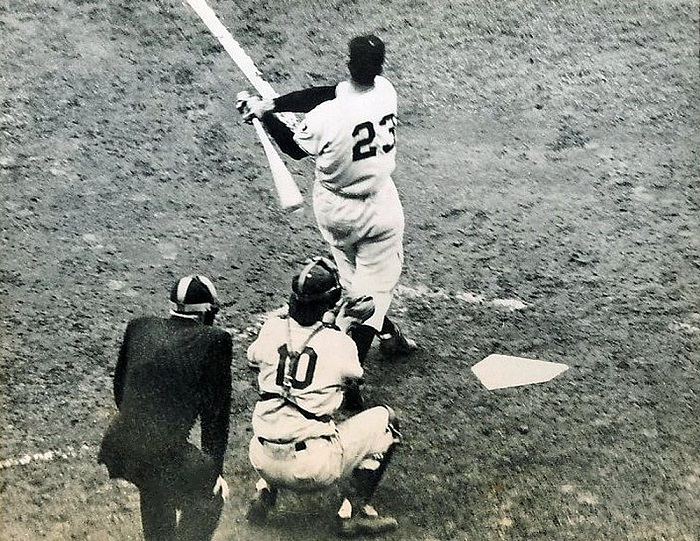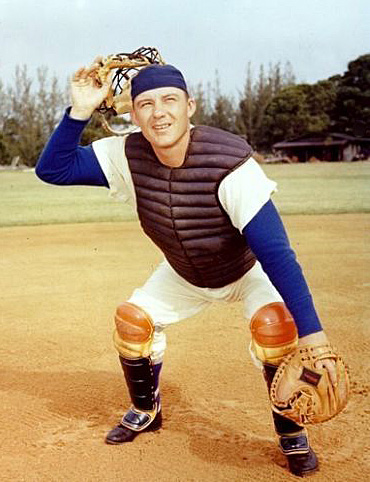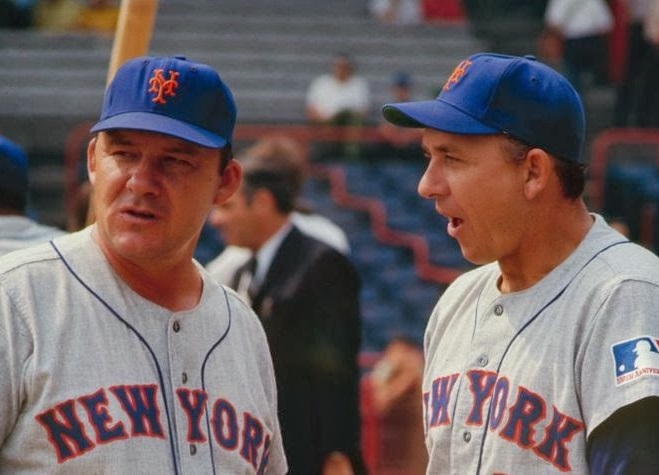I began following the Brooklyn Dodgers in the spring of 1952. As often mentioned, I was captured by the voice of Vin Scully when by chance I turned the dial of my radio and picked up a Dodger broadcast out of Brooklyn. Duke Snider sealed the deal with a home run that evening.
For me some of the greatest times in my baseball fan life came when I was alone in my bedroom in Lunenburg, Nova Scotia keeping score as Vin called the shots.
I was so fortunate to begin my Dodger fan career at a time when I could pencil Roy Campanella, Duke Snider, Jackie Robinson, Pee Wee Reese, Gil Hodges, Carl Furillo, Carl Erskine, Don Newcombe and others into my homemade score card. Sandy Koufax and Don Drysdale were not yet on the scene at that time.
While I loved the exploits of those mostly Hall of Fame players, I also became very familiar with players who played back up and bench roles with the team. One such individual, and indeed a true character in the game, was catcher Rube Walker. I recall he excelled at throwing out would be base stealers and he was often described as the slowest runner in the game. He was a popular teammate and no doubt the butt of many base-running jokes. “That guy, ‘ said a Dodger coach, “isn’t as slow on the bases as he looks. He’s slower!”
Rube Walker was born in Lenoir, North Carolina in 1926. He attended high school in Lenoir and was signed by the Chicago Cubs as an amateur free agent in 1944.
Walker played three years in the Cubs farm system culminating in a tremendous campaign with the Nashville Volunteers of the Southern Association in 1947. Along with 22 home runs, he drove in 105 runs and posted a hefty .331 batting average.
Walker was called up to the Cubs in 1948 and in his rookie season, he appeared in 79 games and hit .275 – both career-highs for the 22-year-old rookie backstop. He was then destined to be a back up catcher for the rest of his career.
Rube Walker was traded to the Dodgers on June 15, 1951 in a trade that also brought left fielder Andy Pafko to Ebbets Field. He was behind the plate – subbing for the injured Roy Campanella – for the infamous Bobby Thompson home run on October 3rd that eliminated the Dodgers in a three-game playoff with the crosstown rival New York Giants.

Most Dodger fan remember that it was Ralph Branca who gave up The Shot Heard ‘Round the World home run to New York Giants third baseman Bobby Thompson on October 3, 1951, but few realize that it was Rube Walker behind the plate for the Brooklyn Dodgers instead of Hall of Fame catcher Roy Campanella, who was out with an injury. (AP photo)
There has been much conjecture about that pitch and accusations of sign stealing by the Giants. That may well be correct but close up witnesses have a bit of a different take on that pitch. Years later, Walker said that pitch was supposed to be a brush back, but “Branca didn’t get the ball far enough inside.”
Giants first baseman Whitey Lockman was on second base when Thompson hit his historic home run. Lockman said he was unable to pick up the signs by Walker. With a runner on second, as was and still is the practice, Walker switched the signs and made them more elaborate.
“I didn’t recognize the sequence,” Lockman said, when asked about it years later.
Walker remained with the Dodgers through the 1958 season – their first in Los Angeles. After only 44 at bats and hitting .114 he was waived. Although his career did not make a big impression on the baseball world, Rube Walker made a definite impression on his teammates with whom he forged some lifetime friendships and with whom he shared mutual respect. He named his first child after Pee Wee’s daughter while his special relationship with Gil Hodges would come home to roost later in his career.
His release by the Dodgers was upsetting to his teammates, especially for the young pitchers who appreciated his catching skills. Walker had earned a deserved reputation for his pitch calling and for throwing out 46% of would be base stealers during his 11-year MLB career.
Upon learning of Walker’s release from the team, Hall of Famer Don Drysdale moaned, “Why does it have to be Rube?” And 1955 World Series MVP Johnny Podres added “I love to pitch to him. When it comes to setting up the hitter, there were none better.”

Although Walker spent his entire career with the Dodgers in the shadow of Hall of Fame catcher Roy Campanella, he was very highly regarded by the entire Dodgers pitching staff. (AP photo)
Beginning in 1959 Walker launched a minor league managing career that took him to stops in Houston, St. Paul, Atlanta, Amarillo, Augusta and Columbus. He was slated to begin the 1965 season in yet another city with the Mets Greenville, South Carolina affiliate. However, his managing career was also to come to an abrupt end. His good friend, the aforementioned Gil Hodges, contacted Walker and asked him to become the pitching coach of the Washington Senators. Hodges had been traded to the Washington Senators in late May of 1963 for outfielder Jimmy Piersall so that he could replace Mickey Vernon as Washington’s manager.
Gil Hodges became the New York Met’s manager in 1968 and brought Rube Walker with him to New York as his pitching coach. Together they were to change the nature of starting rotations in baseball and were also fortunate to have inherited some fine young arms on the major league roster and in the farm system.
Walker was a firm believer that there were only so many pitches in an arm. He watched over his young staff somewhat like a mother hen and it is said that he even instituted “Walker’s Law” that no pitcher was allowed to throw without him knowing about it. He was criticized a bit for babying his pitchers but he saw that as a write-off compared to protecting those young arms. Based on his experience as a catcher and looking at the long haul he believed he had found a way that would keep his pitchers stronger and healthier over the grind of a long 162 game season.
The big change Rube Walker instituted was the now standard five-man pitching rotation. There had been instances of five-man rotations prior to Walker’s mandated rotation but those were for short periods of time in response to injuries or schedules including doubleheaders bunched up to complete schedules. Walker’s five-man rotation, along with the approval of manager Gil Hodges, is seen to be the first as a philosophical change. His first such rotation included Tom Seaver, Jerry Koosman, Gary Gentry, Don Cardwell and Jim McAndrew.
The Miracle Mets went on to win the 1969 and although there were undoubtedly many factors at play in the unexpected success, the five-man rotation may have been one of the prime factors, as well as helping Seaver, Koosman, Cardwell and some fellow named Nolan Ryan enjoy lengthy major league careers.
The Dodgers and the rest of major league baseball soon followed with five-man rotations patterned after the Rube Walker model.

Rube Walker (left) is credited with becoming the first to utilize a five-man pitching rotation while serving a pitching coach for Mets manager and former Dodger great Gil Hodges (right).
(AP photo)
The Mets manager and his pitching coach remained together until Hodges’ sudden and fatal heart attack on April 2, 1972 – just two days before his 50th birthday. Hodges and his good friend and former teammate Rube Walker, along with Mets coaches Joe Pignatano and Eddie Yost, had just completed a round of golf in West Palm Beach, Florida when Hodges collapsed on their way back to their motel.
Following the death of his good friend, Walker continued on as the pitching coach with the Mets under managers Yogi Berra, Roy McMillan, Joe Frazier and Joe Torre. He followed Torre to Atlanta in 1982 and remained with the Braves until Torre was fired in 1984.
Walker became a scout – ending his 40 years in uniform – for the Braves and then the Cardinals for the next seven years.
When Tom Seaver was inducted into the Hall of Fame in 1992, he had invited Walker to attend the ceremony but his well respected pitching coach had been diagnosed with cancer was was too weak to attend.
Albert “Rube” Walker died on December 12, 1992 in Morganton, North Carolina. He was 66 years of age.
Upon learning of Walker’s death, Seaver said this about his close friend and former coach: “He was a pitcher’s pitching coach.”




 February 7th, 2016 at 6:00 am
February 7th, 2016 at 6:00 am  by Harold Uhlman
by Harold Uhlman  Posted in
Posted in 

Minor correction: Johnny Podres was World Series MVP in 1955. Larry Sherry was WSMVP in 1959.
Editor’s error. Fixed. Thanks.
Excellent piece Harold.
As always I enjoy reminiscing about the good old days, Thanks Harold for a most interesting article, I have to admit that I was unaware that Walker was so responsible for the 5-man rotation.
The Dodgers were right on his heels and in the early 70’s went to five man rotations because they had five good starters. What a luxury, eh.
1971- Sutton, Singer, Downing, Alexander and Osteen.
Tom Seaver credits the length of his career to Rube Walker.
Going to a 5-man rotation changed the game forever. And although I applaud it and do not want to see it disappear, the 5-man rotation – along with today’s situational and specialized relief roles – mean that Randy Johnson is (probably) the last 300-game winner we will ever see – at least in our lifetimes.
Rube was my 1st cousin. I was small when he was playing for the Dodgers. He and other adult cousins visited us often and would play ball in the pasture above our house in Kings Creek, about 13 miles from Lenoir. I sat on his lap once at an old-fashioned corn shucking. He took me to the county fair when I was nine. He brought my mother and baby sister home from the hospital in 1951. He came to visit my family when my brother, Howard Walker, was killed in Vietnam in 1966. My mother and I went to an Atlanta Braves game in 1990 and saw Rube there when he was scouting for the St. Louis Cardinals. That was the last time I saw him. He was a wonderful cousin that all of us were proud of. Joe Torre came to Rube’s funeral and I talked with him. Rube brother, Verlon, who coached the Chicago Cubs, was also an important part of our family.
Hi Louise! Marlene Lerner here. I just came across this article and your response. Rube was a very big figure in my life as I grew up. His oldest, Debbie, and I were great friends. He insisted that every summer he and the family return to Lenoir so he could be with family and that the girls could have a normal life. His wife, Millie, always had poodles, mid-sized, who had long sharp nails. Rube. I remember vividly, made us an omelet in the oven. I was so impressed that he cooked because my dad sure didn’t! I also remember seeing the photos on the wall of every baseball star, including Babe Ruth.
Rube was a modest down-home guy and I just adored him. If you know where Debbie is, I would love to get in touch with her. By the way, your mom was the best!!
Hope you get to see this and hope you’re well.
Marlene
The downside to the 5 man rotation is there are 30 more starters in MLB. Obviously those are not the 30 best.
Back in the day pitching staffs were typically 10 man. Today they’re 12 man. That leaves the bench short handed. I’m wondering if anybody has ever considered expanding the active rosters to 27. Likely enough teams that don’t want that extra million plus in payroll have that idea blocked. MLBPA would like it though.